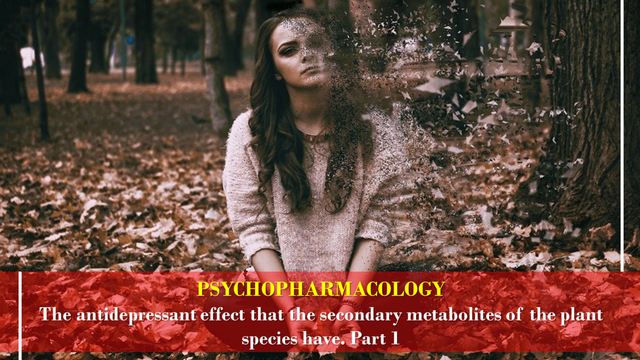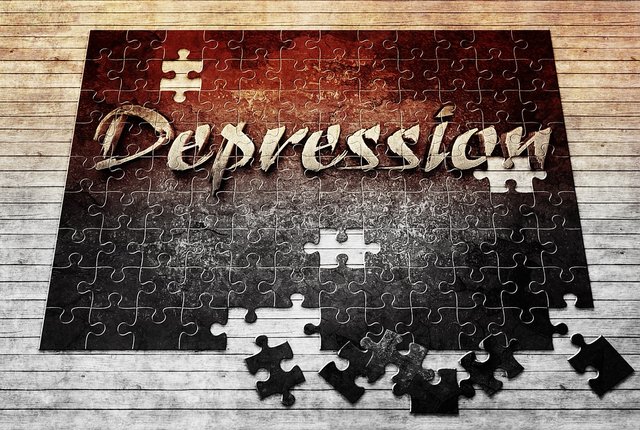
This is an opportunity to share with all users of #Hive social network, especially with friends of @Project.HOPE, a scientific-technical synthesis on Psychopharmacology (area of psychology that studies the physiological action of drugs on cognitive, emotional and behavioral disorders in people), specifically on aspects related to the phytopharmacological effect, which have secondary metabolites of plant species, this time I will present key aspects on the antidepressant potential exhibited by some plant species to treat this type of psychological condition.
In boxing terms, in the last decade a struggle has been unleashed related to the development of drugs and phytopharmaceuticals, in the constant search to create increasingly effective drugs for the treatment of psychological disorders or disorders of a depressive nature, and this can be seen in each of the divergent positions on the use of synthetic drugs to treat different mental states, and the applications of drugs of plant origin as an important alternative that already shows experimental and clinical support.

Fig. 2 Depression as a psychological condition, generates sleep disorders and a feeling of tiredness. Image of public domain, Author: Darkmoon, 2017
The pharmacological industry, for the development and formulation of psychological prescription drugs, has been supported by the scientific results that have been derived from the academic interdiscipline where professionals of botany and photochemistry have been taken into account, this with the purpose of considering and including the positive effects that have the secondary metabolites that are present in plant species, and its action on multiple psychological disorders, however, there are several experimental and clinical dilemmas that must be clarified, basically to know the real potential of the plant species, and its possible uses as a therapeutic treatment in people with psychological profile problems.
However, it should be noted that some secondary metabolites present in plant species, have behavior analogous to neurotransmitters, and it has been reported that they exhibit biochemical effects that manage to activate the transfer of nerve impulses in humans, generating antidepressant metabolic disorders that are partly some of the functions performed by certain commercial synthetic drugs, nevertheless, species like the Cannabis sativa (Marijuana) are able to generate these same effects in the people, reason why, they can be used with therapeutic aims under controls and specific formulations that do not cause adverse nor addictive effects in patients with psychological disorders.

Fig. 3 Some secondary metabolites present in plant species, prescribe elevated mood and increased energy in people. Image of public domain, Author: Avantrend, 2014
Another plant species, with analogous behavior to neurotransmitters of antidepressant action is the plant species Erythroxylum coca (Coca), which has also been used experimentally for anesthetic purposes in patients with psychological disorders, mainly by its direct response on the neurotransmission system, on the other hand, the secondary metabolites present in this plant species also tend to produce elevated mood, increased energy, and increased verbal fluidity in patients with certain psychological complications.
The secondary metabolites of Banisteriopsis caapi (Ayahuasca), also prescribe antidepressant potentiality, this according to multiple descriptive reports where it is indicated that, the tea used from ancestral times by Amazonian Indians, not only possesses psychotropic properties, but also it can induce a transitory modified state of the conscience, with outcomes of introspection, visions, increase of the emotions, and appearance of personal memory, element of great utility for the professions of the psychology.
The context developed in this publication, shows the interest in linking the use of plant species in the treatment of psychological prescription, which can be administered by professionals in this important area of mental health, so I think that from this entry will generate various concerns of users of the platform, however, the main ideal is to go socializing information as an input to know the potential that gives us Mother Nature.

Fig. 4 Observing the natural environment carefully and quietly, from the psychological point of view, generates satisfaction and confidence. Image of public domain, Author: Geralt, 2014
To conclude, this set of information on Psychology and Rehabilitation, as well as aspects related to Psychopharmacology, I will compete in a frequency of publication of two (02) articles per week, provided that the pace of work allows me to develop complete material to share with all of you.
BIBLIOGRAPHICAL REFERENCES CONSULTED:
[1] Domínguez E., Soler J., Elices M., Pascual J., Álvarez E., and Riba J. Ayahuasca: Pharmacology, neuroscience and therapeutic potential. Brain Research Bulletin. 2016; 13. Article: Online access
[2] Tres J. Interaction between medicines and medicinal plants. An. Sist. Sanit. Navar. 2006; 29; 2: 233-252. Article: Online access
[3] Sellers E., and Frcp C. Clinical pharmacology and therapeutics of benzodiazepines. Cma Journal. 1978; 118: 1533. Article: Online access
[4] Ritter J., Lewis L., Mant T., and Ferro A. A Textbook of Clinical Pharmacology and Therapeutics. 2008; 476. Article: Online access